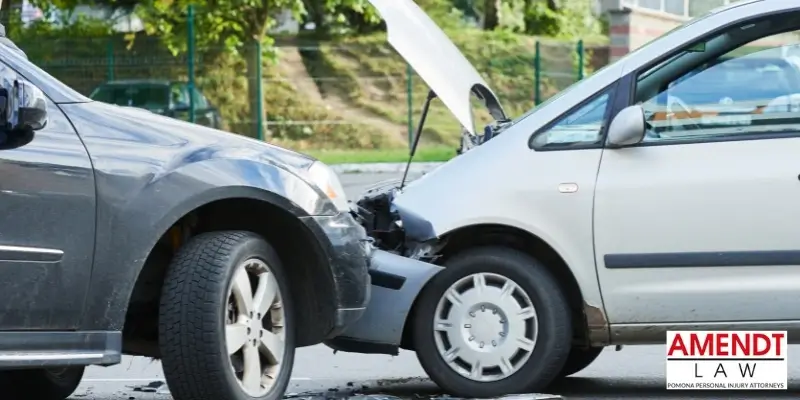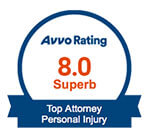Call Us : (909)-766-1994
California Car Accident Laws 2025 – All You Need to Know

Whenever you are driving, it’s important to know and understand the traffic laws of the state you are traveling in. California car accident laws reflect the state’s busy highways and the high number of accidents each year. The state has developed a legal framework that determines the fault of the accident, helps manage insurance claims, and keeps the safety of all road users at the forefront.
When to Hire a Car Accident Lawyer
If you have been involved in a car accident in California and you have questions about what your next steps are, it may be time to hire an experienced car accident lawyer. The legal team at Amendt Law is able to answer questions, guide you on decisions, and represent you through the legal terrain involving the accident you have been in. Our attorneys have the knowledge of California laws needed to help you seek the compensation you deserve.
Understanding California Car Accident Laws
It is essential for both drivers and victims involved in accidents to understand the latest California car accident laws. Fault determination, insurance requirements, legal procedures, and new legislative changes are the focus of the current laws and regulations surrounding car accidents in California.
Insurance Requirements in California
All drivers are required to carry a minimum amount of auto insurance to legally operate a vehicle on public roads in California. Liability insurance, these minimum limits, are designed to cover the costs associated with an accident in which the driver is found at fault. The minimum coverage is:
- $15,000 for injury or death of one person in an accident
- $30,000 for injury or death of more than one person
- $5,000 for property damage
To protect against the significant financial consequences that can arise from accidents, many experts recommend purchasing a higher cover than what the legal minimum is to adequately protect against the significant financial repercussions that can arise from serious accidents.
Some drivers opt to still drive even if they don’t have auto insurance, which leads to another set of problems if they are involved in an accident. If a driver is unable to show proof of insurance after they are in an accident, they can face penalties, fines, and suspension of driving privileges.
New Insurance Laws in California
California has introduced several changes to insurance laws in recent years. These updated regulations further protect consumers and address the needs of the state’s traffic ways. These include:
- Temporary Car Insurance for Rental Vehicles. The law now includes provisions that regulate temporary car insurance policies for drivers renting vehicles.
- Uninsured/Underinsured Motorist Coverage. Drivers are encouraged to carry this type of coverage in California, as it helps cover costs if you’re in an accident with a driver who either doesn’t have insurance or doesn’t have enough to cover your damages.
- Proposed Legislation on Insurance Practices. The state has been considering new bills designed to limit the amount of time an insurance company can take to settle claims.
California’s Fault-Based System
The state operates under a fault-based system, meaning the at-fault driver of the accident is held liable for the damages. When it comes to determining who is responsible for property damage, medical expenses, and other accident-related costs, this part is crucial. Assigning fault is handled through negotiations between insurance companies or the court if a lawsuit is filed.
Typically, in the form of auto insurance, California drivers must maintain proof of financial responsibility to cover the costs of any injuries or damages they have caused in an accident. Protecting the financial interests of both parties is the intention of this law.
Statute of Limitations in Car Accidents in California
The statute of limitations in California for accidents is important to understand so a person knows the timeframe they have to file a claim or sue the responsible party for an accident. A person has a two-year statute of limitation for personal injuries that were a result of the accident, and a three-year statute of limitation for property that was damaged during the accident.
Comparative Fault and Negligence
Under the comparative fault rule in California, each party may be assigned a percentage of fault for the accident. If you are partially at fault for the accident, you may still recover damages, but your compensation will be reduced by the percentage of fault assigned to you.
Laws on Distracted Driving
California has many laws related to distracted driving within the state. The laws and regulations continually evolve as technology changes and new practices arise. Some of the major laws related to distracted driving are that cell-phone use is prohibited while driving, that includes handheld devices and texting. Since E-scooters and E-bikes are becoming increasingly popular, California has responded by requiring the use of helmets on these motorized vehicles.
As of 2024, additional bills have been proposed for in-car infotainment systems and driver assistance technology, as some critics have argued these new technologies are causing more distractions for drivers.
FAQs
What Are the Pedestrian and Bicycle Safety Laws in California?
California has passed several laws aimed at protecting the safety of pedestrians and bicycles on the roadway. These include pedestrian right-of-way laws, bicycle lane protections, and increased penalties for those who block bike lanes or fail to give cyclists enough space when passing. The state is also part of the Vision Zero initiative, which implements safer road designs, enforces speed limits, and uses public education campaigns to change driver behavior.
What Laws Does California Have Related to Self-Driving Cars?
The current laws that California has in place related to self-driving cars are the liability in autonomous vehicle accidents and testing and use regulations. The state is active in regulating self-driving vehicles, ensuring they meet all safety standards. California has also passed specific laws governing the testing and deployment of these vehicles.
What Are the Legal Procedures After an Accident in California?
After a car accident in California, there are several steps and legal proceedings that one should take. The first is to report the accident. Then, decide what damages you want to pursue and which claims support your interests. Contacting an experienced car accident lawyer in California can help you through these legal steps and guide you on the route you wish to take during this difficult time.
What Happens if a Minor Crashes a Car in California?
In California, if a minor crashes a car, the law states that the parent will be responsible for any damages they have caused in the accident. Although there are several factors to consider, such as the legal age to drive, the possession of a valid driver’s license, and whose car they were driving, the steps following the accident are generally the same as those when adults are the drivers in a crash.
Contact Amendt Law
If you or someone you know has been in an accident, or if you just have questions regarding the specific laws related to car accidents in California, contacting a knowledgeable lawyer may help you understand the state’s regulations. The legal team at Amendt Law is well-versed in California’s car accident and traffic laws and is able to answer any questions you may have. Give our office a call today to talk with one of our experienced attorneys.


